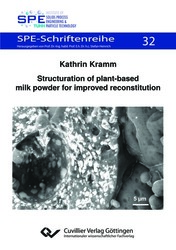| Areas | |
|---|---|
| Serie de libros (96) |
1377
|
| Nachhaltigkeit |
3
|
| Gesundheitswesen |
1
|
| Letra |
2361
|
| Ciencias Naturales |
5403
|
| Ciencias Ingeniería |
1788
|
| Ingeniería | 291 |
| Ingeniería mecánica y de proceso | 861 |
| Ingeniería eléctrica | 685 |
| Mineria y metalurgía | 30 |
| Arquitectura e ingeniería civil | 75 |
| General |
97
|
|
Leitlinien Unfallchirurgie
5. Auflage bestellen |
|
Erweiterte Suche
Structuration of plant-based milk powder for improved reconstitution (Volumen 32) (Tienda española)
Kathrin Kramm (Autor)Previo
Lectura de prueba, PDF (1,1 MB)
Indice, PDF (140 KB)
The importance of plant-based milk alternatives has grown rapidly in recent years, with powdered forms gaining particular interest in the food industry. However, these powders often form lumps when reconstituted with water, making them unsuitable for consumers and food applications. To address this, the dissolution process must be optimized through precise particle design and control of powder properties.
This study focuses on structuring plant-based products by forming agglomerates, which are influenced during high-pressure homogenization, spray drying, and fluidized bed spray granulation. The research investigates how processing conditions and formulation components—especially plant proteins and fibers—affect emulsion and powder properties to create a viable alternative to cow’s milk for industrial use, including collaboration with Nestlé S.A.
Spray drying produces solid primary particles that encapsulate the oil phase of the emulsion, which are then used in the fluidized bed process. Detailed product characterization reveals differences in formulations before and after agglomeration. An alternative, more cost-effective manufacturing route for plant-based milk powders is also explored.
A statistical design of experiments is applied to analyze the relationship between process parameters, particle structure, and reconstitution behavior. Results confirm numerical simulations of the agglomeration mechanisms, allowing identification of optimal process settings for improved dissolution with fewer lumps. Inline and offline analyses further clarify the correlation between particle size, structure, and solubility.
Additionally, the study examines the reconstitution process in detail, considering raw material properties, powder composition, and solvent effects. A modeling approach complements experimental work to better understand the physical processes involved. Overall, the thesis provides a foundation for applying efficient particle design and optimized manufacturing processes to more complex plant-based milk powder systems in the food industry.
| ISBN-13 (Impresion) | 9783689523541 |
| ISBN-13 (E-Book) | 9783689523558 |
| Formato | B5 |
| Idioma | Inglés |
| Numero de paginas | 194 |
| Laminacion de la cubierta | mate |
| Edicion | 1. |
| Serie | SPE-Schriftenreihe |
| Volumen | 32 |
| Lugar de publicacion | Göttingen |
| Lugar de la disertacion | Technische Universität Hamburg |
| Fecha de publicacion | 30.09.2025 |
| Clasificacion simple | Tesis doctoral |
| Area |
Allgemeine Verfahrenstechnik
|
| Palabras claves | emulsion, spray drying, fluidized bed agglomeration, reconstitution, soy protein, oat fiber, lipid encapsulation, lump characterisation, swelling, design of experiment, targeted particle design, Emulsion, Sprühtrocknung, Wirbelschichtagglomeration, Rekonstitution, Sojaprotein, Haferfaser, Lipidverkapselung, Klumpencharakterisierung, Quellung, Versuchsplanung, gezielte Partikelgestaltung |








